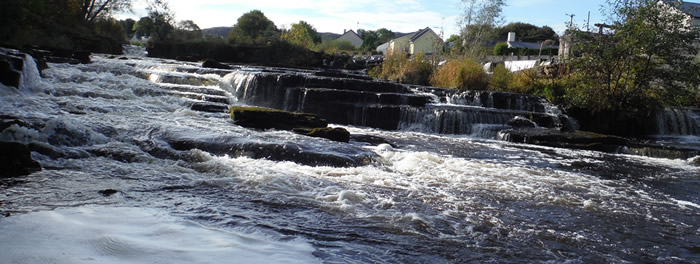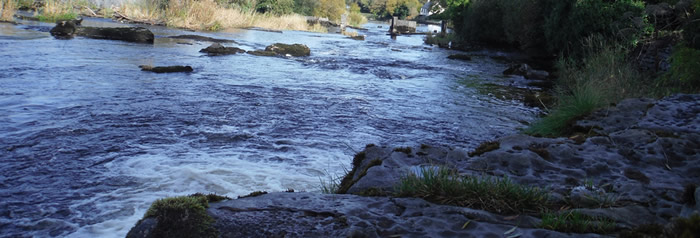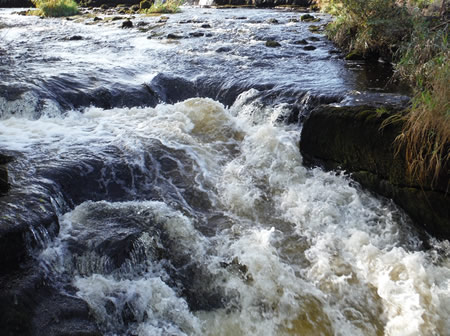About Ballisodare Fishing Club

Historically the Ballisodare River was never known as a salmon river and records in relation to salmon catches prior to 1850 would indicate that less than 20 salmon were caught in the river system in any year. The simple reason for this was that salmon had to negotiate a waterfall in excess of twenty feet high right at the mouth of the river to reach the lower stretches of the river, and a further set of falls at Collooney barred their passage to the Owenmore River.
The fishing rights were originally owned by the Crofton family but were purchased by Edward Joshua Cooper around 1806. The Cooper family had extensive land holdings in the Collooney/Ballisodare Area and more importantly were members of Parliament in London from time to time.
 On June 30th 1837 the London Parliament passed an Act to enable Edward Joshua Cooper “to establish and protect a salmon fishery upon the lakes and rivers of Owenmore and Arrow and also within the bay of Ballisodare in the Count of Sligo in Ireland”.
On June 30th 1837 the London Parliament passed an Act to enable Edward Joshua Cooper “to establish and protect a salmon fishery upon the lakes and rivers of Owenmore and Arrow and also within the bay of Ballisodare in the Count of Sligo in Ireland”.
The Act known as the “Cooper Act” allowed for the construction of a salmon ladder and the purchase of any other existing fishing rights and it gave the sole and exclusive fishing rights to the Cooper family for salmon and all sea going fish, including eels and sea trout.
The salmon ladder at the Ballisodare falls was completed in 1852 and was the first of its type in Europe. This allowed salmon to access the upper reaches of the system on the Lough Arrow side. The numbers of salmon caught started to rise as salmon began to spawn in the streams and returning numbers steadily increased.
In 1854 just 179 salmon were caught but by 1859 that number had risen to 2,000 and by 1863 the numbers caught had risen to 6,000 salmon.
Two significant additions were made to the system which further increased the returning numbers and which helped to develop the fishery into a significant commercial business.
A second salmon ladder was constructed at the Collooney falls including a resting pool and this allowed salmon to access the Owenmore system right up to the spawning beds in the Ox Mountains beyond Coolaney. The streams in this area where the Owenmore rises are located within a few hundred meters of similar streams that are the feeder streams for the River Moy, another prolific salmon river.

The second significant addition was the construction of a salmon hatchery in 1883 and brood salmon were brought from the Tay in Scotland, the Edne in Norway and the Rhine in Germany. The hatchlings were brought to spawning beds at the extremity of the system in an attempt to further increase the returning shoals of salmon through the spring and summer. It has been claimed that the most successful brood stock were those taken from the Rhine.
By the end of the 19th Century annual catches in excess of 10,000 fish were the norm making the fishery a considerable commercial success. Ice from the North Atlantic was brought to Sligo and packed into caves or “ice houses” in the Ballisodare area. As the season progressed between May and September each year, peaking in June/July, salmon were netted on the tide. The salmon were then packed into long timber boxes with rope handles, three fish per box, lying on a bed of ice and topped with more ice before being closed. The boxes of fish were brought to the train station and transported to Dublin, and from there by ship to England arriving at the London fish market within 24 hours of being caught.
 This successful business continued well into the twentieth century. The Fishery went into decline from the 1950’s due to a variety of reasons and was eventually sold to Ballisodare Fishing Club, the current owners, in the mid 1990’s.
This successful business continued well into the twentieth century. The Fishery went into decline from the 1950’s due to a variety of reasons and was eventually sold to Ballisodare Fishing Club, the current owners, in the mid 1990’s.
The fishery by that stage was considerably run down and in need of restoration. Fish returns had declines considerably and many of the spawning beds were no longer operating. Two hydro-electric generating schemes were also now operating in the river system and conflicted in some ways with the operation of a fishery.
Considerable works have been undertaken in the last two decades by Ballisodare Fishing Club to upgrade the fishery in order to provide high quality salmon fishing for local anglers and tourists alike. This undoubtedly has been achieved with fishermen taking up to 2,000 and more salmon each year by rod and line methods.
These catches are mainly taken in the Ballisodare area, on safe beats both above and below “The Falls” at the river mouth. This high quality sport fishing is enjoyed by fishermen from all over Ireland, England, Scotland, Wales and many continental countries.
Fishing further up river has not been developed to date given that significant investment was required to restore the fishery to its original highly productive state. It is now acknowledged that the numbers of salmon returning have significantly increased.
Working with Inland Fisheries Ireland, an electronic counter has been installed in the ladders at the lower falls and gives an accurate count of all fish that get up into the system. The figures have increased steadily with recent counts of over 13,000 salmon going up into the system in one season. It is also clear from the counts that Ballisodare is one of very few North Atlantic salmon fisheries to record increased returns in the last decade, which reflects favourably on the considerable efforts of the Club, its board of directors and the fishery staff.




